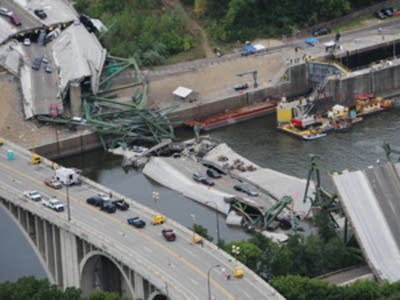NTSB final report: Bad design, plus added weight, led to bridge collapse
Go Deeper.
Create an account or log in to save stories.
Like this?
Thanks for liking this story! We have added it to a list of your favorite stories.

Investigators for the National Transportation Safety Board have concluded that under-designed gusset plates and the weight on the bridge deck were the primary causes of the I-35W bridge collapse, Minnesota Public Radio News has learned.
The bridge collapsed the evening of Aug. 1, 2007, killing 13 people.

The role of the under-sized gusset plates in the disaster was first revealed last January in a preliminary report from the NTSB. However, the role of weight on the bridge is a new finding.
MPR News has been told that the two inches of pavement added to the bridge deck in the 1990s, and the presence of 270 tons of construction equipment and materials on the bridge the day of the collapse, triggered a "cascading effect" that led to the failure of the span, in effect pushing the structure beyond its capacity.
Turn Up Your Support
MPR News helps you turn down the noise and build shared understanding. Turn up your support for this public resource and keep trusted journalism accessible to all.
NTSB investigators have also concluded that bridge engineers and inspectors did not have a system in place to double- and triple-check that all factors and safety features of the bridge were sound, MPR news also learned.
One MNDOT bridge inspector had noticed that gusset plate U10 was bowed. However, that problem was not part of the analysis of the bridge's safety by MnDOT and URS Corp., the consulting firm it had hired to help with bridge inspections.

The U10 gusset plate was one of those that was under-designed, according to the NTSB's earlier reports.
NTSB investigators also ruled out one maintenance issue as a factor. The investigators have determined that corrosion on the bridge's steel did not play a significant role in the collapse.
The investigators' findings will be presented at an NTSB hearing in Washington DC, which begins tomorrow morning and will last through part of the day on Friday.
Based on those findings, the board will make safety and policy recommendations to the Federal Highway Administration and state transportation officials on bridge safety.
While the NTSB report is the final word on the cause of the collapse, it does not assign blame.





